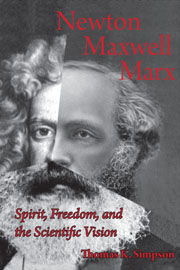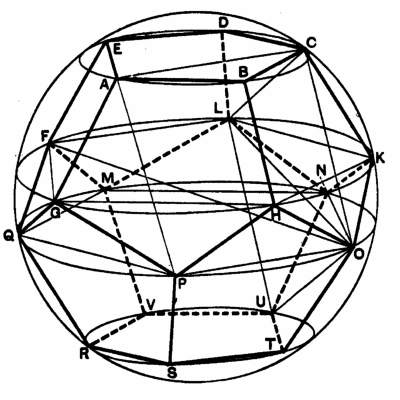We have been tracing the course of the book, NEWTON/MAXWELL/MARX by way of a dialectical tour of three worlds of thought. We have seen Maxwell replace Newton’s “Laws of Motion” with the Principle of Least Action as the foundation of the natural world. Here, we seek the meaning of this curious phrase, Least Action.
Let’s grant that Maxwell – along with perhaps most of the mathematical physicists of our own time – is right in supposing that the Principle of Least Action governs all the motions of he physical world. How can we make sense of this truth? What is Action, and why is essential that it be Least?
First, we must begin by recognizing nature is not inert, but in some sense purposeful: every motion in the natural world (and that includes practically everything we can point to, once we take our hands off the controls!) will begin with a goal (Greek TELOS). Think, for example, of that complex process by which an acorn develops into a flourishing oak. This Motion will unfold in such a way that its goal will be achieved in the most efficient way possible. Sound like good economics? We’re asked to see every natural motion as directed to some goal, and as unfolding in such a way that waste or loss en route be the least possible under the given circumstances.
This principle can be expressed elegantly in mathematical terms, rather esoteric and belonging to the hushed domain of mathematical physics. But since it is actually in play everywhere around us, in actions going on at all times, it’s time we reclaimed it and demanded to know what it means. Let’s make a serious effort here to understand the implications that the physicists – Maxwell chief among them – have been saying.
For Maxwell, the true paradigm of physics is the laboratory of Michael Faraday, working immediately with phenomena and tuned always to hear, without complication of intervening symbols, the authentic voice of nature. The Principle of Least Action is about the world we live in.
However we may distort and engineer it, it is always nature, ever-active, with which we begin, and our projects end. We may think we begin with a tabula rasa and design with total mastery to purposes of our own, but every blade of grass, infinitely quantum-mechanical-wise, will laugh at us. It is in the fields and the mountains, the atmosphere and the oceans, and the endlessly-complex workings of our own bodies, that Nature’s economics is inexorably unfolding. High time, that we take notice of it!
We begin always with some process – the fall of a stone, from cliff’s edge to the beach below or the slow unfolding of an acorn into a flourishing oak. The principle applies in every case. Further, nature thinks always in terms of the whole process as primary: the economic outcome cannot be conceived as the summation of disparate parts, however successful each might seem in its own terms.
The unifying principle throughout any motion is always its TELOS, and it is this which in turn entails an organic view of the motion as one undivided whole process. Each phase of the motion is what it is, and does what it does, precisely as it contributes to the success of the whole. If this seems a sort of dreamland, far from practical reality, we must remind ourselves that we are merely rephrasing a strict account of what Nature always does! Things go massively awry (the seeding gets stepped on by the mailman) but these events are external constraints upon the motion: under these constraints, the Principle holds, strictly. Ask any oak tree, blade of grass, or aspen grove. Each has endured much in the course of its motion, yet each has contributed, to the extent possible, to the success of the ecology of which it is a part.
Economic achievement of the goal, we might say, is Nature’s overall fame of mind. Within this frame, exactly what is the economic principle at work? Everything moves in Nature in such a way that Action over the Motion will be least.
So, what is action? Action is the difference, over the whole motion, between two forms of energy: kinetic and potential Nature wants that difference to be minimal: that is, over the whole motion, the least potential energy possible to be expended, en route, as kinetic – i.e., as energy of motion. (One old saying is that Nature takes the easy way.) Or we might suggest: nature enters into motion gracefully.
Think of the falling stone: the stone at the edge of a high cliff has a certain potential energy with respect to the beach below. That potential is ready to be released – converted into kinetic energy, energy of motion. Thus the TELOS is given: to arrive at the beach below, with that high velocity equivalent to the total potential with which the fall began.
Our principle addresses the otherwise open question, how exactly to move en route? There is just one exact answer: the rule of uniform acceleration – steady acquisition of speed. Galileo discovered the rule; Newton thought he knew the reason for the rule. But Maxwell recognized that Newton was wrong, and we need now to get beyond this old way of thinking.
The real reason for the slow, steady acceleration is that the final motion, which is the TELOS, be acquired as late in the motion as possible, and thus that total-kinetic-energy-over-time be least.
Our principle may turn out to be of more intense interest to biologists than to physicists, as the ”kinetic energy” in this case becomes life itself. The seed bespeaks life in potentia. The ensuing show, steady conversion of potential—its gradual conversion to living form as the seedling matures – is the growth of the seeding, the biological counterpart of the metered, graceful fall of the stone.
Our principle governs the whole process of conversion: the measured investment of potential into kinetic form defines the course of maturation. Nature is frugal in that investment: the net transfer of energy-over-time is minimal; transfer in early stages of growth is avoided. Growth, like the fall of the stone, is measured, and graceful. Growth is organic in the sense that every part of the plant, at every stage of the way, is gauged by its contribution to the economic growth of the whole plant.
As it stands, our analogy to the falling stone may be misleading. It is not, of course, the case that the seed holds in itself (like loaded gun!) the potential energy of the oak; the case is far more interesting. The acorn holds in its genome the program for drawing energy from the environment in a way which will assure Least Action over the whole growth process. Once again, frugality reigns, since that energy not drawn-upon by the seedling will be available to other components of the ecology. Since the solar energy is finite, whatever is not used by one is available to the others.
We are ready now to ask in larger terms, “What sense does it make, that Nature be thus frugal in expending potential energy – minimizing its “draw” upon potential in early stages of growth, though total conversion by the end of motion be its very TELOS?
The question is a difficult one, touching on the very concept of life itself. Here, however, is my tentative suggestion. Let us consider Earth’s biosphere as a newborn project, awaiting Nature’s design. Our Earth (like, no doubt, countless other “earths” in Nature’s cosmic domain) is favored with a certain flux of energy, in the form of light from our Sun: just enough, on balance, to sustain water in liquid form, one criterion, at least, for the possibility of life. With regard to Earth, then, Nature’s overall TELOS may reasonably be characterized as the fullest possible transformation of sunlight into life. Earth also offers a rich inventory of mineral resources, which Nature will utilize to the fullest, over time, in the achievement of this goal.
Might we not think of this immense process, still of course very much ongoing, in the terms we’ve used earlier – as one great motion, transforming as fully as possible the potential energy of sunlight, into the living, kinetic energy of life? (It might be objected that the flux of solar energy is kinetic, not potential. It is so in space, en route, but is made accessible as potential by that immense solar panel, the green leaf system of the world – which by its quantum magic captures photons, uses them to split water, and thus generate the electrochemical potential on which the motion of life runs.)
That said, we may apply the logic of Least Action to life on every scale: life’s TELOS is to encapsulate our allotted solar potential energy in living form, always by way of the most frugal path possible. What is saved by the Least Action of one life-motion, is grist for the mills of others – so that overall, the solar flux is utilized as fully as possible. “As fully as possible” at this stage: but the long, slow motion of evolution continues – always, no less governed by Least Action, towards a TELOS we cannot envision, yet of which we must be organically a part, today.
For an expansion of this concept, you can read an earlier lecture: The Dialectal Laboratory: Towards a Re-thinking of the Natural Sciences
NEXT: Karl Marx and his place in Newton/Maxwell/Marx.










